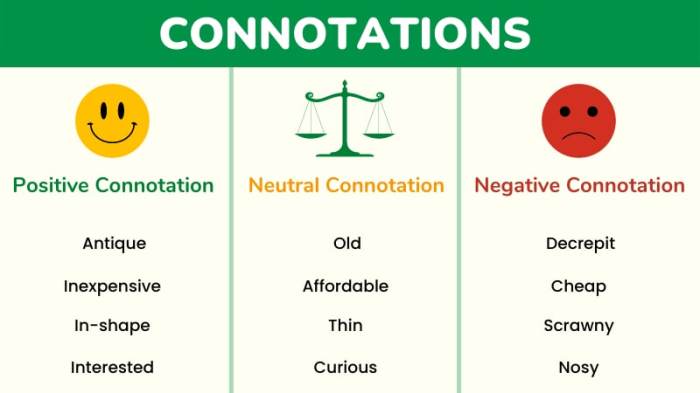Which sentence contains the strongest use of emotional connotation? This question delves into the realm of language and its power to evoke emotions, shaping our perceptions and interpretations. By exploring the key characteristics of sentences with strong emotional connotation, we can unlock the secrets of effective communication and enhance our writing skills.
Emotional connotation refers to the emotional associations and implications conveyed by words and phrases, beyond their literal meanings. It can profoundly impact the reader’s response, influencing their feelings, thoughts, and actions. Understanding emotional connotation is crucial for crafting compelling narratives, persuasive arguments, and impactful messages.
Emotional Connotation in Sentences

Emotional connotation refers to the emotional associations or implications that words or phrases evoke. It plays a significant role in sentence construction by influencing the reader’s perception and interpretation of the text.
Sentences with strong emotional connotation can elicit powerful reactions and shape the reader’s understanding of the message being conveyed. Understanding emotional connotation is essential for effective communication and writing.
Identifying Strong Emotional Connotation
Sentences with strong emotional connotation often exhibit certain key characteristics:
- Use of emotionally charged words (e.g., love, hate, joy, anger)
- Figurative language (e.g., metaphors, similes, imagery) to evoke emotions
- Sensory details that appeal to the reader’s senses
- Strong verbs and adjectives that convey intensity
- Personal anecdotes or examples that resonate with the reader
Techniques for Analyzing Emotional Connotation
To identify the emotional connotation of words and phrases, consider the following strategies:
- Examine the context in which the words are used
- Identify the connotations associated with individual words
- Analyze the use of literary devices such as metaphors, similes, and imagery
- Consider the tone and style of the writing
Examples and Case Studies, Which sentence contains the strongest use of emotional connotation
Examples of sentences with varying levels of emotional connotation:
- Neutral: “The cat sat on the mat.” (Low emotional connotation)
- Positive: “The radiant sunbeams danced upon the shimmering lake.” (Moderate emotional connotation)
- Negative: “The deafening roar of the thunder shattered the tranquility of the evening.” (Strong emotional connotation)
Practical Applications
Understanding emotional connotation can enhance writing and communication skills by:
- Evoking desired emotions in the reader
- Creating a compelling and engaging narrative
- Persuading or informing the reader
- Building rapport and establishing connections
General Inquiries: Which Sentence Contains The Strongest Use Of Emotional Connotation
What is emotional connotation?
Emotional connotation refers to the emotional associations and implications conveyed by words and phrases, beyond their literal meanings.
How can emotional connotation impact the reader’s response?
Emotional connotation can profoundly impact the reader’s response, influencing their feelings, thoughts, and actions.
What are some techniques for analyzing emotional connotation?
Techniques for analyzing emotional connotation include identifying the emotional associations of words and phrases, examining the use of literary devices, and considering the context in which the language is used.

